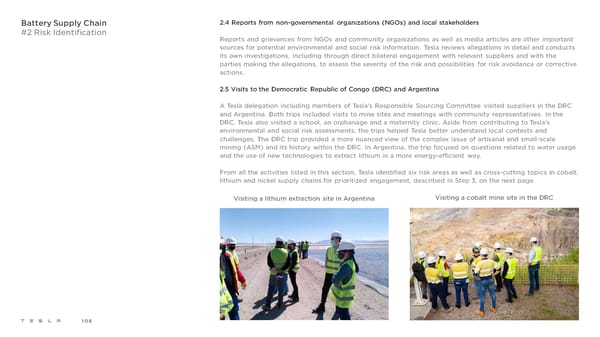Battery Supply Chain 2.4 Reports from non-governmental organizations (NGOs) and local stakeholders #2 Risk Identification Reports and grievances from NGOs and community organizations as well as media articles are other important sources for potential environmental and social risk information. Tesla reviews allegations in detail and conducts its own investigations, including through direct bilateral engagement with relevant suppliers and with the parties making the allegations, to assess the severity of the risk and possibilities for risk avoidance or corrective actions. 2.5 Visits to the Democratic Republic of Congo (DRC) and Argentina A Tesla delegation including members of Tesla’s Responsible Sourcing Committee visited suppliers in the DRC and Argentina. Both trips included visits to mine sites and meetings with community representatives. In the DRC, Tesla also visited a school, an orphanage and a maternity clinic. Aside from contributing to Tesla’s environmental and social risk assessments, the trips helped Tesla better understand local contexts and challenges. The DRC trip provided a more nuanced view of the complex issue of artisanal and small-scale mining (ASM) and its history within the DRC. In Argentina, the trip focused on questions related to water usage and the use of new technologies to extract lithium in a more energy-efficient way. From all the activities listed in this section, Tesla identified six risk areas as well as cross-cutting topics in cobalt, lithium and nickel supply chains for prioritized engagement, described in Step 3, on the next page. Visiting a lithium extraction site in Argentina Visiting a cobalt mine site in the DRC Tesla team visiting a lithium brine operations in Argentina 106
 Tesla 2021 Impact Report Page 105 Page 107
Tesla 2021 Impact Report Page 105 Page 107